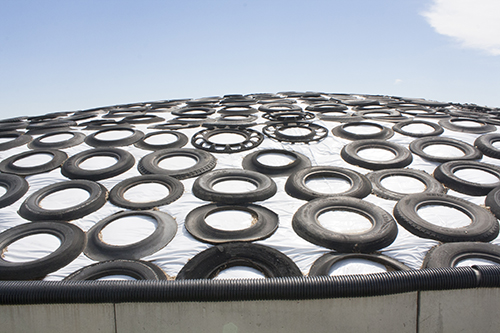by Amanda Smith, Associate Editor 
Plastic covers are a convenient and effective method to help preserve our silage piles. When silos are not promptly sealed, fewer sugars are available for fermentation. As a result, less acid is produced and the pile's pH stays high.
"Silage acids are healthy. Lactic acid helps preserve dry matter while acetic acid prevents spoilage. The pile is more prone to spoiling upon opening, when fewer acids are produced," noted Michelle Windle, at the Vita Plus Dairy Summit.
Windle then discussed producers' plastic options.
The use of standard polyethylene plastics originated in Europe likely as a way to repurpose fumigation plastic. After a pile is covered, tires help exclude oxygen from the pile and can limit its spread if a hole is made in the plastic.
Meanwhile, barrier plastics have a polyamide additive that limits oxygen penetration. "Oxygen barrier technology is useful and worth the extra work," continued Windle.
"With an oxygen barrier, there is often less dry matter loss in the top 24 inches of the pile, and it is more stable after it is opened. With lower oxygen levels, yeast multiplication is inhibited, limiting spoilage.
Oxygen barrier plastics should have a "cling factor" much like Saran wrap. This enables the plastic to mold to the contours of the pile and eliminate oxygen pockets.
A "two-in-one" (black and white plastic with oxygen barrier properties) is often a thicker plastic that may be reinforced with cross hatching fibers. The plastics are rolled together, which saves labor, but researchers question how well the plastics separate upon ensiling.
The labor convenience comes at an additional cost. The two-in-one plastics may also lack the "cling factor" that enables an oxygen barrier plastic to quickly eradicate oxygen. "If the face isn't managed properly, these plastics may flap in the wind," added Windle.
While convenience is the appeal of a two-in-one, research is limited and some question the quality of the oxygen barrier film.
"Not all oxygen barrier plastics are equal. There is a very wide range in how much oxygen is let in," noted Windle.
"With oxygen barrier plastics, such as Silostop, you don't want to pull the layer tight and stretch it out. You want it to be able to cling and fill in cracks," noted Chris Wacek-Driver, also with Vita Plus. The black and white layer, though, should be pulled tight.
"You also need to watch the type of shoes your employees wear when covering the pile. Shoes with any type of heel can puncture or stretch the plastic and create an opportunity for oxygen to get in," she continued.
To comment, email your remarks to intel@hoards.com.
(c) Hoard's Dairyman Intel 2015
December 21, 2015

Plastic covers are a convenient and effective method to help preserve our silage piles. When silos are not promptly sealed, fewer sugars are available for fermentation. As a result, less acid is produced and the pile's pH stays high.
"Silage acids are healthy. Lactic acid helps preserve dry matter while acetic acid prevents spoilage. The pile is more prone to spoiling upon opening, when fewer acids are produced," noted Michelle Windle, at the Vita Plus Dairy Summit.
Windle then discussed producers' plastic options.
The use of standard polyethylene plastics originated in Europe likely as a way to repurpose fumigation plastic. After a pile is covered, tires help exclude oxygen from the pile and can limit its spread if a hole is made in the plastic.
Meanwhile, barrier plastics have a polyamide additive that limits oxygen penetration. "Oxygen barrier technology is useful and worth the extra work," continued Windle.
"With an oxygen barrier, there is often less dry matter loss in the top 24 inches of the pile, and it is more stable after it is opened. With lower oxygen levels, yeast multiplication is inhibited, limiting spoilage.
Oxygen barrier plastics should have a "cling factor" much like Saran wrap. This enables the plastic to mold to the contours of the pile and eliminate oxygen pockets.
A "two-in-one" (black and white plastic with oxygen barrier properties) is often a thicker plastic that may be reinforced with cross hatching fibers. The plastics are rolled together, which saves labor, but researchers question how well the plastics separate upon ensiling.
The labor convenience comes at an additional cost. The two-in-one plastics may also lack the "cling factor" that enables an oxygen barrier plastic to quickly eradicate oxygen. "If the face isn't managed properly, these plastics may flap in the wind," added Windle.
While convenience is the appeal of a two-in-one, research is limited and some question the quality of the oxygen barrier film.
"Not all oxygen barrier plastics are equal. There is a very wide range in how much oxygen is let in," noted Windle.
"With oxygen barrier plastics, such as Silostop, you don't want to pull the layer tight and stretch it out. You want it to be able to cling and fill in cracks," noted Chris Wacek-Driver, also with Vita Plus. The black and white layer, though, should be pulled tight.
"You also need to watch the type of shoes your employees wear when covering the pile. Shoes with any type of heel can puncture or stretch the plastic and create an opportunity for oxygen to get in," she continued.
(c) Hoard's Dairyman Intel 2015
December 21, 2015





